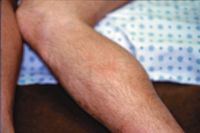- Acne
- Actinic Keratosis
- Aesthetics
- Alopecia
- Atopic Dermatitis
- Buy-and-Bill
- COVID-19
- Case-Based Roundtable
- Chronic Hand Eczema
- Chronic Spontaneous Urticaria
- Drug Watch
- Eczema
- General Dermatology
- Hidradenitis Suppurativa
- Melasma
- NP and PA
- Pediatric Dermatology
- Pigmentary Disorders
- Practice Management
- Precision Medicine and Biologics
- Prurigo Nodularis
- Psoriasis
- Psoriatic Arthritis
- Rare Disease
- Rosacea
- Skin Cancer
- Vitiligo
- Wound Care
Article
Look for infections presenting atypically in immunocompromised patients
New York - Looking for unusual manifestations of common infections and treating them aggressively are keys to managing infections in immunocompromised patients.
New York - Looking for unusual manifestations of common infections and treating them aggressively are keys to managing infections in immunocompromised patients.

Condition on the rise Speaking at the American Academy of Dermatology's Academy '04 here, Dr. Murakawa says the condition is on the rise because as diagnostic abilities have improved, more congenital immunodeficiency syndromes are identified; treatments for cancer and other malignancies also contribute to the increasing number of immunocompromised patients.
"With the combination of all these diseases, we are seeing a steady rise in the overall population in the number of immunosuppressed patients in general," says Dr. Murakawa, associate professor and chair of the department of dermatology at Wayne State University School of Medicine, Detroit.
Common, uncommon Immunocompromised patients can present with both common and uncommon diseases, but identifying the unusual manifestations is critical to clearing the patient of infection.
"Think of uncommon conditions when things just don't quite fit," recommends Dr. Murakawa.
For example, he suggests that an immunocompromised patient presenting with a multifocal cellulitis could actually be diagnosed with a Helicobacter cinaedi cellulitis, which istypically seen in homosexual males who are HIV positive but may have relatively high CD4 T-cell counts.
"If a patient with HIV is not responding or is moving toward end stage disease, then you have to think about very uncommon manifestations," he explains.
Dr. Murakawa advises , "When things look a little more atypical, larger or just do not fit the normal scenario, you really have to think outside the box."
For example, he says a tinnea infection in an immunocompromised patient could involve the patient's entire body, not just a portion of it.
Bacterial skin infections caused by S. aureus or S. pyogenes can occur in both healthy and immunocompromised patients, but present atypically or more severely in an immunocompromised patient.
Be aggressive, thorough When zeroing-in on a diagnosis and taking biopsies and cultures in an immunocompromised patient, Dr. Murakawa recommends aggressiveness and thoroughness.
For biopsies, "Make sure to get sufficient amounts of tissue to make a diagnosis," he says.
For some cultures, one may need to make a special request for culturing certain organisms that might not be grown under standard culture conditions. For instance, a lab may not typically culture for something unusual like acanthamoebiasis or bacillary angiomatosis.
"If you do not ask for it, and if your lab is not prepared to grow it, you are not going to get the answer you are looking for. You need to have a little broader of a differential," he tells Dermatology Times.
"When doing cultures and biopsies, you may diagnose unusual manifestations of common infectious organisms."
Once a diagnosis has been made, it is time to move quickly, he says, an antibiotic course should be prolonged one at maximal doses.
"Once you make a diagnosis, be very aggressive with therapeutics. If you are not quick on picking up things, like disseminated zoster, these (immunocompromised) patients go downhill quickly."
An immunocompromised patient who has staph pyoderma may require a course of antibiotics that lasts one month or longer to be cleared. The typical 10-day course recommended for uncomplicated skin and soft tissue infection is probably not enough, according to Dr. Murakawa.
Newsletter
Like what you’re reading? Subscribe to Dermatology Times for weekly updates on therapies, innovations, and real-world practice tips.











